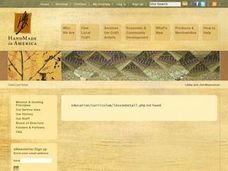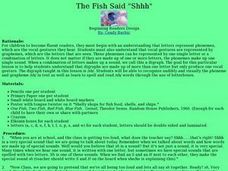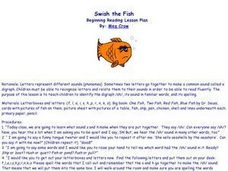Curated OER
Digital Photography and Landforms
Fifth graders create a picture book of local landforms using digital cameras. They also illustrate two vocabulary terms by hand and locate pictures of other geography vocabulary terms in magazines. Students take picture-taking field...
Curated OER
User-friendly rivers
Learners explore and explain their connection to rivers through watersheds. They break into three groups. Each group needs: Blue enamel paint, Miniature objects to simulate a model river system, modeling clay, Tempera paint, Toothpicks...
Curated OER
What is the Best Solution to Dye Easter Eggs?
Young scholars use red and blue litmus paper to determine the category of common substances. They then set up an experiment using vinegar, water, and ammonia (or milk of magnesia) to determine that acids make the best solution for dyeing...
Curated OER
Creating a digital Self-Portrait
Sixth graders use a digital camera and take photographs of each other wearing a "costume" of their choice in front of a blue screen. They work cooperatively to complete the photographs by placing it into a background and setting...
Curated OER
The Battle of Gettysburg
Eighth graders participate in a basketball game that involves taking on the roles of Union and Confederate armies. In two teams, each wearing either gray or blue fabric strips, they attempt to capture their opponents and free their own...
Curated OER
Where in the World is Carbon Dixoide?
Students conduct experiments designed to detect the presence of CO2 by using a BTB that changes color (blue to yellow) in the presence of CO2. First, students experiment with the CO2 from combining vinegar and baking soda. In part two,...
Curated OER
Sexual Reproduction and Meiosis
In this biology worksheet, 9th graders create one chromosome using a red plasticine and another using blue plasticine. Then they illustrate different ways of crossing over, including double crossovers. Students also explain genetic...
Curated OER
Color Me
In this color me worksheet, students color and illustrate four tropical fish: blue head, queen trigger fish, Garibaldi and blue-striped grunt.
Curated OER
Using Operations
In this problem solving activity, students read the strategies and steps to solve word problems. Students solve 2 problems about blue whales.
Curated OER
Color and Shapes
In this shape coloring worksheet, students color the squares red, the circles blue, and the triangles green. There are 9 shapes on this page to color.
Curated OER
E-Excellent Elephant
In this letter e worksheet, students color the e's in a picture the color blue, then color any other letters they see a different color. Students count the e's, then practice writing the letter at the bottom of the page.
Curated OER
Challenge: Square and Circle
In this shape instructional activity, students color squares orange, circles blue, and count and write the numbers of each shape present. A clown is shown juggling the shapes.
Curated OER
Sampling Techniques
Sixth graders examine how to select samples and apply them to an experiment. In this sampling lesson, 6th graders use a bag of yellow and blue cubes to take a sample. They predict how many of each color there are the bag. They set up and...
Curated OER
Swimming with Crabs
Students explore Earth science by completing several graphic organizer activities in class. In this oceanography lesson, students research ocean inhabitants such as blue crab and oysters. Students complete graphic organizers about the...
Curated OER
Exhaust, Gas and Pollution
Students watch a demonstration of how bromthymol blue is used to indicate the presence of carbon dioxide in a gas. They design their own experiments to test gasses which are suspected of containing carbon dioxide.
Curated OER
Direction of River Flow
Students determine the direction the river flows. They use a US map with rivers listed, colored pencils and a compass or transparency with directions marked. Students use a color key to determine which direction the river is flowing...
Curated OER
The Phases of the Moon
Students observe the questions, "Why do we say there is a man on the moon?, What do you think of when you hear "the moon is made of cheese"?, What is meant, to you, by the expression "Once in a blue moon"? and a comic of Snoopy typing,...
Curated OER
I Like to Shuffle Along in My Shiny Shoes
Young scholars study the letters s and h as they blend together to make one sound. They practice making the sound, reciting a tongue twister while stretching the sh sound, and writing the letters. Next, they make words using letter boxes...
Curated OER
Shhh Here and There
Pupils identify words containing the sh digraph in this lesson. They say a tongue twister which contains words emphasizing the sh digraph. They then read with a partner "One Fish, Two Fish, Red Fish, Blue Fish" and identify words in...
Curated OER
The Fish Said "Shhh"
Students identify the digraph /sh/ in written and spoken language. After a brief discussion of the independent and combined sounds of the phonemes /s/ and /h/ students practice identifying initial and final placement of the new digraph...
Curated OER
Fishy Fish
Students complete a variety of activities as they explore the letter 'f'. Through instruction and modeling they examine the sound the letter makes, how to make the sound with their mouths, how the letter is written, etc. They recite...
Curated OER
F is for Fish
Young scholars study the letter "F, f" in order to recognize it, say its sound, and write it. They watch a partner's mouth as they make the "f" sound before repeating a tongue twister that contains many "f" sounds. Next, they practice...
Curated OER
Swish the Fish
Students study the /sh/ phoneme by making the sound, and reciting a tongue twister. Next, they make words that the teacher models using their Elkonin letterboxes. While using the big book version of Dr. Seuss', One Fish, Two Fish, Red...
Curated OER
Solve for Scale Factors Using Proportions
Eighth graders solve problems using proportions with scaled drawings. They work with maps and blue-prints discussing scales and plans and examine different polygons and figure out the scale factors or proportions they have been changed by.

























